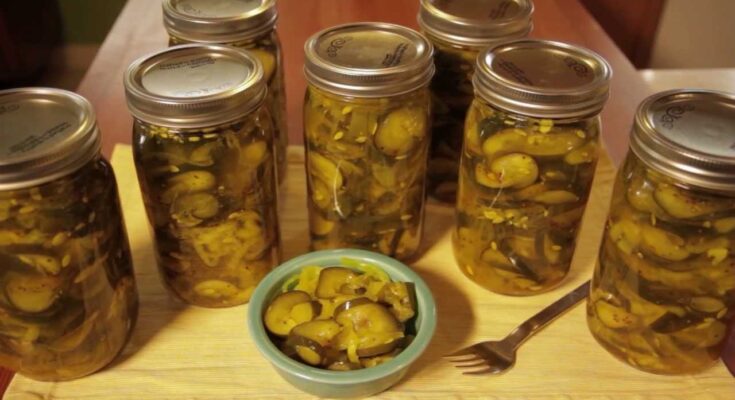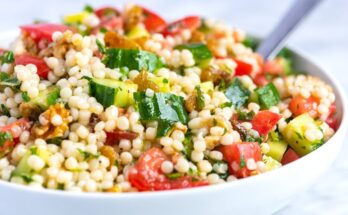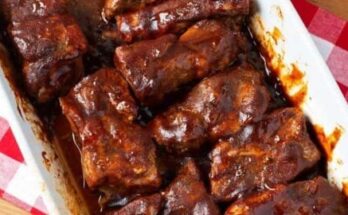Bread and Butter Pickle Recipe: Bread and butter pickles are a beloved staple in many households. They combine the perfect balance of sweetness and tang, making them ideal for a variety of dishes. Whether you’re a seasoned cook or new to pickling, this guide will walk you through the entire process.
What are Bread and Butter Pickles?
Bread and butter pickles are sweet, tangy, and slightly spiced cucumber pickles. They are made with a vinegar brine, sugar, onions, and spices like mustard seeds, turmeric, and celery seeds. These pickles stand out for their distinctively sweet and zesty flavor, which pairs beautifully with savory dishes.
History and Origin
The origin of bread and butter pickles dates back to the early 20th century. Legend has it that farmers Omar and Cora Fanning popularized the recipe during the Great Depression. They traded their homemade pickles for household staples like bread and butter, hence the name. Over the years, this recipe became a comfort food in many American homes.
Why Are They Called Bread and Butter Pickles?
The name is often misunderstood to mean that the pickles should be eaten with bread and butter. However, the true story behind the name is rooted in the Depression-era trade practices of the Fanning family, who bartered the pickles for basic necessities.
Popular Uses for Bread and Butter Pickles
Bread and butter pickles are incredibly versatile. They’re commonly used to top burgers and sandwiches, adding a burst of flavor. They’re also great on charcuterie boards, paired with cheese and cured meats, or even enjoyed straight from the jar.
Ingredients Needed for Bread and Butter Pickles
For the perfect batch of bread and butter pickles, having the right ingredients is crucial. Here’s a breakdown of what you’ll need.
Essential Ingredients
- Cucumbers (Kirby or pickling cucumbers are ideal)
- Onions (sweet or white onions)
- Vinegar (white distilled vinegar is most common)
- Granulated Sugar
- Salt (non-iodized pickling salt works best)
- Spices (mustard seeds, celery seeds, turmeric, black peppercorns)
Optional Ingredients for Flavor Variations
- Garlic cloves for extra flavor
- Red pepper flakes for a spicy kick
- Bell peppers for added texture and sweetness
These optional ingredients allow you to customize your pickles to suit your taste preferences.
Tools and Equipment Required
Before you begin, it’s essential to gather the right tools. This will make the process smoother and ensure your pickles turn out perfectly.
Kitchen Tools You’ll Need
- A large pot for boiling the brine
- Cutting board and knife for slicing cucumbers and onions
- A colander for draining excess water
- Mixing bowls
- Measuring cups and spoons
- Mason jars with lids for canning
How to Properly Sanitize Canning Jars
Sanitizing your jars is crucial to prevent bacteria from spoiling your pickles. Follow these steps:
- Wash jars with hot, soapy water.
- Submerge the jars in boiling water for 10 minutes.
- Let the jars air dry on a clean towel.
Proper sanitation ensures a longer shelf life for your pickles.
Preparing the Cucumbers and Onions
Now that you have your ingredients and tools ready, it’s time to prep the vegetables.
Selecting the Right Cucumbers
Choose firm, unblemished cucumbers. Pickling cucumbers are ideal because they have fewer seeds and a crisper texture. Avoid overripe cucumbers, as they can become too soft when pickled.
Slicing and Salting the Vegetables
Slice the cucumbers and onions evenly to ensure consistent pickling. Sprinkle them with salt to draw out excess moisture. This step helps maintain the crunchiness of the final product.
Letting the Vegetables Rest for Maximum Flavor
After salting, let the vegetables rest for about 2-3 hours. This allows them to release water and absorb the salt, which enhances their flavor and texture.
Creating the Pickling Brine
The brine is the heart of this recipe. It’s what gives the pickles their signature sweet and tangy taste.
Ingredients for the Brine
- White vinegar
- Granulated sugar
- Salt
- Mustard seeds
- Turmeric
- Celery seeds
Steps to Make the Brine
- In a large pot, combine vinegar, sugar, and salt.
- Add the spices and bring the mixture to a boil.
- Stir until the sugar and salt dissolve completely.
Tips for Perfect Brine Consistency
Make sure the sugar is fully dissolved to avoid a grainy texture. If you prefer a more tangy taste, reduce the sugar slightly. For a sweeter brine, add an extra ¼ cup of sugar.
Cooking and Combining the Ingredients
Once your brine is ready and the vegetables have been prepped, it’s time to cook and combine everything. This process allows the flavors to fully blend.
Boiling the Brine Mixture
After dissolving the sugar and salt in the vinegar, bring the mixture to a gentle boil. Be sure not to overboil, as this can weaken the vinegar’s acidity, which is crucial for proper pickling.
Adding Vegetables to the Brine
Carefully add the salted cucumbers and onions to the boiling brine. Stir gently to ensure all the vegetables are coated evenly in the liquid.
Simmering for Flavor Infusion
Lower the heat to a simmer and cook the mixture for about 5-7 minutes. This helps the vegetables absorb the brine’s flavor without becoming too soft. Be careful not to overcook, as this can lead to mushy pickles.
Canning the Bread and Butter Pickles
Now that your pickles are ready, it’s time to move on to the canning process. Proper canning ensures your pickles remain fresh and safe to eat for months.
Proper Canning Techniques
- Use sanitized mason jars that have been boiled and dried.
- Carefully ladle the hot pickle mixture into the jars, leaving about ½ inch of space at the top.
- Wipe the jar rims to remove any brine that could prevent a proper seal.
- Place the lids on the jars and screw on the bands tightly but not too firm.
Sealing and Storing the Pickles
To create a vacuum seal, process the jars in a water bath canner for 10-15 minutes. Once sealed, let the jars cool at room temperature. You’ll know they’re sealed properly when the lids no longer pop when pressed.
How Long Do Pickles Need to Cure?
Although you might be tempted to eat them right away, bread and butter pickles need time to develop their full flavor. Let the jars sit for at least two weeks before opening. The longer they cure, the more intense the flavors will become.
Tips for Perfect Bread and Butter Pickles
Making pickles may seem simple, but a few extra tips can take your pickling game to the next level.
Choosing the Right Vinegar
White distilled vinegar is the most popular choice because it has a neutral flavor. However, you can experiment with apple cider vinegar for a slightly sweeter and fruitier taste. Avoid vinegars with low acidity, as they may not preserve the pickles properly.
How to Maintain Crunchiness
The secret to crunchy pickles lies in salting the cucumbers and onions beforehand to draw out moisture. Additionally, avoid overcooking the vegetables in the brine. Some people also add a pinch of calcium chloride (pickle crisp) to maintain texture.
Balancing Sweet and Tangy Flavors
Achieving the perfect balance of sweetness and tang is crucial. Adjust the sugar and vinegar ratios to suit your preferences. A good starting point is a 2:1 sugar-to-vinegar ratio, which you can tweak based on taste.
Common Variations and Add-Ins
While the traditional recipe is delicious, there’s always room for creativity. Here are some popular variations.
Spicy Bread and Butter Pickles
Add a pinch of red pepper flakes or sliced jalapeños to the brine for a spicy twist. You can also experiment with different levels of heat by using cayenne pepper.
Garlic-Infused Pickles
For a robust, savory flavor, add a few peeled garlic cloves to each jar. The garlic will infuse the pickles with a rich aroma and taste.
Using Different Vegetables
Although cucumbers are classic, you can also pickle other vegetables like carrots, cauliflower, and bell peppers. These variations add color and texture to your pickle jars.
Serving Suggestions and Pairings
Bread and butter pickles aren’t just for snacking. They can elevate many dishes with their sweet and tangy flavor.
Sandwiches and Burgers
Add a few slices of bread and butter pickles to your favorite sandwiches and burgers. They provide the perfect contrast to rich meats and creamy condiments.
Charcuterie Boards
Pickles are a fantastic addition to any charcuterie board. Pair them with cheeses, cured meats, and crackers for a gourmet appetizer spread.
Other Creative Pairings
Try serving bread and butter pickles with fried chicken, barbecue ribs, or grilled cheese sandwiches. You can even chop them up and mix them into potato salad or coleslaw for added flavor.
Storing and Preserving Bread and Butter Pickles
To ensure your pickles stay fresh and flavorful, proper storage is essential.
Short-Term Storage Options
If you’re not canning the pickles, store them in the refrigerator. They should last up to 2-3 months when kept in airtight containers.
Long-Term Preservation Tips
For long-term storage, use the water bath canning method. Properly sealed jars can last up to a year in a cool, dark place. Be sure to label the jars with the date of preparation.
Signs of Spoilage to Watch For
Always check for signs of spoilage before consuming pickles. If you notice mold, a foul odor, or cloudy brine, discard the jar. Additionally, if the jar lid pops open too easily, the seal may have been compromised.
Health Benefits and Nutritional Value
Pickles aren’t just tasty; they also offer several health benefits.
Nutrients in Bread and Butter Pickles
Bread and butter pickles contain vitamins and minerals like vitamin K, potassium, and calcium. However, keep in mind that they’re also high in sugar and sodium, so enjoy them in moderation.
Benefits of Fermented and Pickled Foods
Pickled foods can support gut health by providing probiotics, which promote healthy digestion. While bread and butter pickles aren’t traditionally fermented, they still offer some digestive benefits due to the vinegar content.
Troubleshooting Common Issues
Sometimes, things don’t go as planned. Here’s how to troubleshoot common problems when making bread and butter pickles.
Why Are My Pickles Too Soft?
Soft pickles may be caused by overcooking or using overripe cucumbers. To prevent this, salt the cucumbers to draw out moisture and avoid extended simmering in the brine.
How to Fix Overly Sweet or Salty Pickles
If your pickles are too sweet, add a splash of vinegar to balance the flavor. For overly salty pickles, you can dilute the brine with water and vinegar before reheating.
Preventing Cloudy Brine
Cloudy brine is often caused by impurities in the salt or vinegar. Use high-quality, non-iodized pickling salt and distilled vinegar for a clearer solution.
FAQs about Bread and Butter Pickle Recipe
1. What are bread and butter pickles?
Bread and butter pickles are sweet and tangy pickles made from thinly sliced cucumbers and onions. They get their unique flavor from a combination of vinegar, sugar, and spices like mustard seeds, celery seeds, and turmeric.
2. How long does it take to make bread and butter pickles?
The process is quite quick. Preparing the cucumbers and onions takes about 15 minutes. After mixing with the brine, they need to sit for about an hour to soak up the flavors. The cooking process itself is only 5-10 minutes. However, for the best flavor, let them refrigerate for at least 24 hours before eating.
3. Do I need any special equipment to make bread and butter pickles?
No special equipment is necessary. You’ll need basic kitchen tools like a knife, cutting board, and a large pot for boiling the ingredients. Jars with tight-fitting lids are essential for storing the pickles.
4. Can bread and butter pickles be made sugar-free?
Yes, you can make bread and butter pickles without sugar by substituting it with a sugar alternative like stevia or erythritol. Keep in mind that the flavor profile might slightly change.
5. How long do homemade bread and butter pickles last?
When stored properly in airtight containers in the refrigerator, homemade bread and butter pickles can last for up to 2 months. Always ensure that they are fully submerged in the brine to maintain their freshness and prevent spoilage.
6. Are bread and butter pickles healthy?
Bread and butter pickles are low in calories and fat but do contain sugar and sodium, which should be consumed in moderation. They also provide some dietary fiber from the cucumbers and have small amounts of vitamins and minerals.
7. What can I serve with bread and butter pickles?
Bread and butter pickles are versatile and can be served with sandwiches, burgers, or hot dogs to add a crunchy, tangy flavor. They’re also a great addition to salads or served as a snack alongside cheese and crackers.


